Fehmarn
Fehmarn (![]() German pronunciation ) (Danish: Femern) is an island in the Baltic Sea, off the eastern coast of Schleswig-Holstein, Germany, and c. 18 kilometers south of the Danish island of Lolland. It belongs to the district of Ostholstein, Germany.
German pronunciation ) (Danish: Femern) is an island in the Baltic Sea, off the eastern coast of Schleswig-Holstein, Germany, and c. 18 kilometers south of the Danish island of Lolland. It belongs to the district of Ostholstein, Germany.
Fehmarn | |
|---|---|
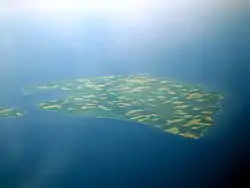 Aerial view | |
 Coat of arms | |
Location of Fehmarn within Ostholstein district 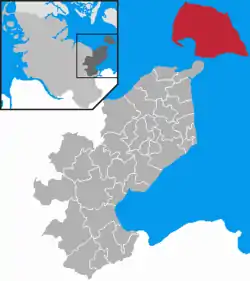 | |
 Fehmarn 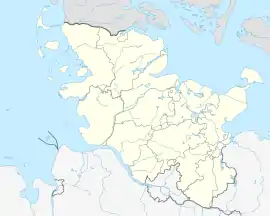 Fehmarn | |
| Coordinates: 54°26′43″N 11°10′13″E | |
| Country | Germany |
| State | Schleswig-Holstein |
| District | Ostholstein |
| Government | |
| • Mayor | Jörg Weber (SPD) |
| Area | |
| • Total | 185.45 km2 (71.60 sq mi) |
| Elevation | 10 m (30 ft) |
| Population (2019-12-31)[1] | |
| • Total | 12,638 |
| • Density | 68/km2 (180/sq mi) |
| Time zone | UTC+01:00 (CET) |
| • Summer (DST) | UTC+02:00 (CEST) |
| Postal codes | 23769 |
| Dialling codes | 04371 und 04372 |
| Vehicle registration | OH |
| Website | www.stadtfehmarn.de |
History
Earlier names of the island are Femera, Fimbria, Cimbria parva, and Imbra.[2] As a part of Wagria it was settled by the Slavic Lechitic tribe of Wagri in the Early Middle Ages; the name derives from Old Slavic fe more (in the sea), modern v more.[3] After their conquest and Christianization, they were progressively Germanized.
From the Middle Ages till 1864 Fehmarn formed part of the Danish Duchy of Schleswig. When the duchy was partitioned in 1544, it formed part of the duchy of John the Elder. Upon his death without heirs in 1580, Fehmarn became part of the Duchy of Schleswig-Holstein-Gottorp. After the Great Northern War Fehmarn along with the rest of Schleswig was united with the Danish crown. In 1864 Schleswig passed to Prussia as a result of the Second Schleswig War.
On 26 July 1932, the German Navy's training ship Niobe sank off the island during a sudden squall, with the loss of 69 lives. At Gammendorfer Strand on Fehmarn, within view of the site of the sinking, the Niobe-Denkmal monument was erected.
Since 1963, Fehmarn has been connected to the German mainland by a road and rail bridge crossing the Fehmarn Sound Bridge. It is 963.40 m (3160.76 ft.) long and 69 m high.
Geography
The area is 185 km² and the coastline is 78 km. The highest hills are the "Hinrichsberg" (27.2 m) and the "Wulfener Berg" (26.5 m). The largest community on Fehmarn is Burg (![]() German pronunciation ) (lit. "the Town of Fehmarn"), with 6,000 inhabitants. In addition, there are many small villages including Vadersdorf.
German pronunciation ) (lit. "the Town of Fehmarn"), with 6,000 inhabitants. In addition, there are many small villages including Vadersdorf.
Transport
The Fehmarn Belt, a strait separating Fehmarn from Lolland, is located on the side opposite to Germany. It can be crossed by ferries travelling between the seaports of Puttgarden, Germany, and Rødbyhavn, Denmark. The crossing takes about 45 minutes.
On 29 June 2007, the Danish and German authorities gave the go-ahead for the Fehmarn Belt Fixed Link tunnel project, planned for completion in 2028.[4]
The aforementioned 963-metre (3,159 ft) long Fehmarn Sound Bridge connects the German island of Fehmarn with the German mainland near Großenbrode.
Nature
The coasts serve as resting places for migratory birds, and it is thus a popular location for ornithologists. The islands bird reserves are looked after by NABU's conservation centre at the Wallnau Waterbird Reserve. In Burg there is a large aquarium with 40 fish tanks.
Fehmarn is famous for its nature and recreation areas, especially during summer times (July–September) and is also well known for its windsurf and kitesurf spots. Currently there are more than ten surfspots known on the island.
Culture
Scharwenzel is a card game for two teams with two to four players on each team. The game is at least three centuries old and is played today only on Fehmarn.
Fehmarn was the location of Jimi Hendrix's final concert, at the Open Air Love & Peace Festival, on September 6, 1970. The concert was held at Flügge Beach in the southwest. There is a memorial stone there and from 1995 through 2010, the Jimi-Hendrix-Revival-Festival was celebrated annually in September.
The St. Nicholas Church has a baptismal font that dates from 1391.[5]
Notable residents
- Jürgen Blin, mid-20th century boxer, was born on the island.
- Lina Heydrich and her husband Reinhard Heydrich had a summer home here, which after the war Lina ran with her second husband Mauno Manninen, as a restaurant and inn until it burned down in February 1969.[6]
- The German expressionist painter Ernst Ludwig Kirchner lived and painted on the island during four summers (1908 and 1912–1914).
Gallery
 Flügge lighthouse
Flügge lighthouse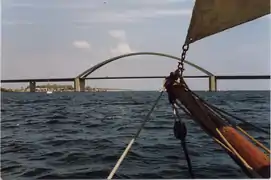 Fehmarn Sound Bridge from the sound
Fehmarn Sound Bridge from the sound Fehmarn sound bridge – view from east
Fehmarn sound bridge – view from east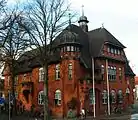 Town hall in Burg
Town hall in Burg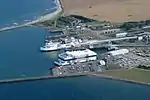 The seaport of Puttgarden
The seaport of Puttgarden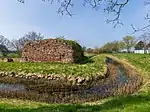 Ruins of the Glambæk castle
Ruins of the Glambæk castle
See also
References
- "Statistikamt Nord – Bevölkerung der Gemeinden in Schleswig-Holstein 4. Quartal 2019 (XLS-file)". Statistisches Amt für Hamburg und Schleswig-Holstein (in German).
- http://www.columbia.edu/acis/ets/Graesse/orblatf.html
- https://www.fehmarn.de/de/fehmarn/fehmarn_im_meer_mittendrin/inselinfos_und_geschichte.php
- http://www.femern.com/Home/Project/Timetable%5B%5D
- St Nikolai Kirche, st-nikolai-kirche-burg.de, retrieved 30 March 2014
- Lehrer, Steven (2000). Wannsee House and the Holocaust. p. 196. ISBN 978-0-7864-0792-7.
External links
| Wikimedia Commons has media related to Fehmarn. |

